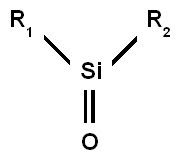 | ||
A silanone in chemistry is the silicon analogue of an ketone. The general description for this class of organic compounds is R1R2Si=O with silicon connected to a terminal oxygen atom via a double bond and also with two organic residues (R). Silanones are extremely reactive and until 2013 have only been detected by argon matrix isolation or in the gas phase but not isolated. A synthesis of a stable silanone was reported in 2014. Silanones are of some interest to academic research.
Silanones are unstable and favor oligomerisation to a siloxane. The reason for this instability is the weak pi bond with a small HOMO–LUMO energy gap caused by an unfavorable overlap between the p-orbitals of silicon and oxygen. A second reason for the observed instability is the strongly polarized Sið+ - Oð− bond.
A stable silanone was reported in 2014. In this compound silicon is bonded to a SIDipp group (1,3-bis(2,6-iPr2-C6H3)imidazolidin-2-ylidene) and a (Cp*)Cr(CO)3 group. Its stability is owed to the direct coordination of silicon to chromium and to steric shielding. The reported Si=O bond length is 1.526 Angstrom and in line with expectation. It has been described as a cationic metallosilanone.
History
The first to postulate a silanone were Kipping & Lloyd in 1901 but their products were in fact siloxanes. Silanones are of some relevance to the double bond rule.
